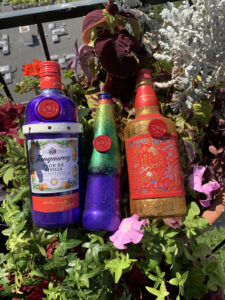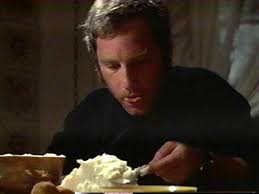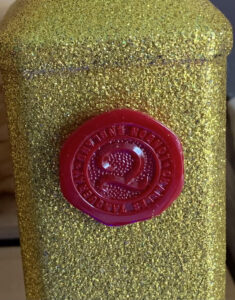
I need to take a day off and just relax, recharge my batteries, reflect.
The most relaxing thing I do these days is paint bottles in glittering gold and entrancing purples. (1)
It’s so experiential, so non-intellectual, to brush on paint, smooth it about, mind the edges.
It’s also bringing back memories of a child in kindergarten, becoming entranced with finger painting. Swishing it on and squiggling it around.
It wasn’t until I was swishing paint on a large bottle in current time that I felt again that same sensation.
Remember Richard Dreyfus in Close Encounters? Molding the mashed potatoes to look like Devil’s Tower?

This means something.
Fingerpainting and this painting I’m doing now are like that: This means something.
Painting is teaching me relaxation, enjoyment, but, most of all, flow. In my experience, flow is a paradigm of the higher realms.
This was the same flow I later discovered in the 2015 heart opening. (1) My heart having explosively opened, I was immediately immersed in a tsunami of love. Ever since then, though not to the same degree, love will flow if I raise it with my inbreath.
The love I encountered must flow, as Michael affirms here: “Love is a fluid energy. It has need to flow.” (2)
It seems to me that discovering flow and beginning to flow with it is and was the purpose of activities like painting in kindergarten and painting now.
***
But why bottles? It goes back to my first job after my second Ph.D. program in History. It’s a funny story. I’ll try not to be too self-serving.
I won a one-year contract replacing a historian on sabbatical in the History Division of the National Museum of Man (now the Canadian Museum of Civilization).
I wondered why we collected artifacts that were three hundred years old and not new artifacts from today. I asked if I could start a demonstration project collecting contemporary artifacts to build a picture of Canadian society in 1973-4. I was given permission as long as it didn’t cost anything.
I and those who worked on the project with me tried to capture our social values as they were represented in consumer products in that year. The project drew national media attention.
Any artifact to go into the collection had to say something about the world we lived in. For example: A picture of a family on a box of soap might show a man in a white shirt and tie, taller than a woman, who was shown in an apron, and a boy or girl in toned-down adult wear. That was how this advertiser wanted us to see his 1973 customers – “average, normal, happy” … and conformist.
I had a network of collectors, across the country, opening their cans, boxes, and cartons from the bottom (so that they were undamaged and appeared new) and sending what they found to me. It was a hoot!
As a result of this, the museum now has an artifactual record of that year that I think will remain unsurpassed. Of course I’m biased.
By the end of my year’s contract, it was the largest collection of artifacts in the museum. The director of museums was wild about it. But my division chief, down the line, was not amused, and so my contract was not renewed.
Damn. I should have laid low. That was a great job!
Afterwards, for the first time in my life, I learned that one can go up an employment ladder easily enough, but one cannot go down as easily. The National Museum of Man was Canada’s premier historical museum.
After unsuccessful contacts among the museum community, my hunch grew that historians at provincial and municipal museums did not want someone from the National Museum in their midst and on their boards. (3) (This might be a projection.)
***
Nevertheless, during that year, I travelled up and down the Ottawa Valley, which is beautiful in autumn. I had a budget for old artifacts; just not for new. It was a heavenly job. I’m laughing at the moment remembering some of my finds. Particularly the carton of Whipper Billy Watson soda pop from the 1930s.
As I look at the shelves of bottles painted in flat and glossy, glitter glue and sparkling stars, all the colors and shapes and combinations take me back and mesmerize me.
One moment I’m back in the museum looking at all the colorful artifacts. The next moment I’m back in kindergarten, being introduced to flow. Speak of everything I needed to learn I learned in kindergarten!
The bottles are just a vehicle to experience the flow of painting. More and more each day, as I paint and even when I don’t, I surrender into the flow.
Footnotes
(1) Archangel Michael in a personal reading with Steve Beckow through Linda Dillon, April 30, 2019.
On both occasions – kindergarten and now – I came in touch through painting with an incipient need and desire to flow.
(2) In which love flowed like a tsunami. See:
- “Submerged in Love,” March 14, 2015, in An Ascension Ethnography at https://goldenageofgaia.com/wp-content/uploads/2021/07/An-Ascension-Ethnography-5.pdf, and after.
- “Activating the Wellspring – Part 1/2,” March 14, 2015, at https://goldenageofgaia.com/2015/03/14/activating-the-wellspring-part-1-2/.
(3) This happened a second time after leaving the Immigration and Refugee Board. The IRB was at the time Canada’s premier tribunal (in the tribunal community). In employment terms, there was nowhere to go but “down.” But people in smaller provincial and municipal tribunals didn’t want an IRB member on their boards. Only a very small number of IRB members I knew found work again in the field.

“Q”

